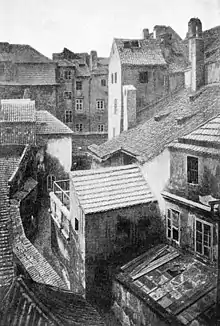Jewish quarter (diaspora)
In the Jewish diaspora, a Jewish quarter (also known as jewry, juiverie, Judengasse, Jewynstreet, or proto-ghetto[1]) is the area of a city traditionally inhabited by Jews. Jewish quarters, like the Jewish ghettos in Europe, were often the outgrowths of segregated ghettos instituted by the surrounding Christian authorities. A Yiddish term for a Jewish quarter or neighborhood is "Di yiddishe gas" (Yiddish: די ייִדדישע גאַס ), or "The Jewish quarter."[2] While in Ladino, they are known as maalé yahudí, meaning "The Jewish quarter".

Many European and Near Eastern cities once had a historical Jewish quarter and some still have it. The history of the Jews in Iraq is documented from the time of the Babylonian captivity c 586 BC. Iraqi Jews constitute one of the world's oldest and most historically significant Jewish communities.
Jewish quarters in Europe existed for a number of reasons. In some cases, Christian authorities wished to segregate Jews from the Christian population so that Christians would not be "contaminated" by them or so as to put psychological pressure on Jews to convert to Christianity. From the Jewish point of view, concentration of Jews within a limited area offered a level of protection from outside influences or mob violence. In many cases, residents had their own justice system. When political authorities designated an area where Jews were required by law to live, such areas were commonly referred to as ghettos, and were usually coupled with many other disabilities and indignities. The areas chosen usually consisted of the most undesirable areas of a city. In the 19th century, Jewish ghettos were progressively abolished, and their walls taken down, though some areas of Jewish concentration continued and continue to exist. In some cities, Jewish quarters refer to areas which historically had concentrations of Jews. For example, many maps of Spanish towns mark a "Jewish Quarter", though Spain hasn't had a significant Jewish population for over 500 years.
However, in the course of World War II, Nazi Germany reestablished Jewish ghettos in Nazi-occupied Europe (which they called Jewish quarters) for the purpose of segregation, persecution, terror, and exploitation of Jews, mostly in Eastern Europe. According to USHMM archives, "The Germans established at least 1,000 ghettos in German-occupied and annexed Poland and the Soviet Union alone."[3]
Europe
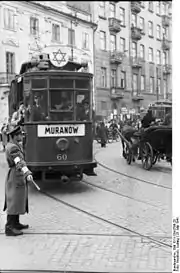
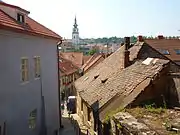
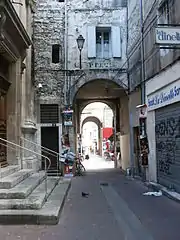
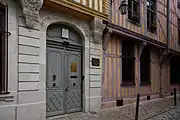
12.jpg.webp)

- Austria
- Belarus
- Dziatlava — Zhetel ghetto
- Minsk — Minsk ghetto (appr. 100,000 Jews, local and those, deported from Austria, Germany and the Czech Republic), during the Second World War
- Belgium
- Antwerp — Joods Antwerpen (35,000 Jews before 1940, 15,000 nowadays)
- Czech Republic
- France
- Bordeaux — Saint-Seurin
- Draguignan — La Juiverie de Draguignan (fr)
- Lyon — La Juiverie de Fourvière and La Guillotière
- Marseille — La Carrière-des-Juifs and Mont-Juif or Montjusieu
- Paris — the Pletzl in Le Marais district
- Les Josiols is a former Jewish quarter situated north of Mirabel-aux-Baronnies
- Germany
- Greece
- Hungary
- Italy
- Caltagirone — Iudeca (Giudecca)
- Catania — Judeca Suprana, Judeca Suttana and Piano di Giacobbe
- Enna — Iudeca (Giudecca)
- Messina — Tirone and Paraporto
- Naples — Giudecca
- Padua — Paduan Ghetto
- Palermo — Meschita and Guzzetta
- Reggio Calabria — La Judeca (Giudecca)
- Rome — Roman Ghetto
- Syracuse — La Jureca (Giudecca)
- Venice — Venetian Ghetto
- Netherlands
- Amsterdam — Jodenbuurt (Amsterdam)
- Amsterdam — Jodenbreestraat (until World War II)
- Amsterdam — Buitenveldert (contemporary)
- Poland
- Portugal
- Belmonte — Judiaria
- Castelo de Vide — Judiaria
- Lisbon — Alfama and Judiaria
- Oporto — Judiaria and Bairro de Monchique
- Romania
- Spain
- Ávila — Judería
- Barcelona — Call[4]
- Bellpuig — Call
- Besalú — Call
- Caceres — Judería
- Calahorra — Judería
- Córdoba — Judería
- Estella-Lizarra — Judería
- Girona — Call Jueu de Girona
- Hervás — Judería
- Jaén — Judería
- León — Judería
- Monforte de Lemos — Judería
- Oviedo — Judería
- Palma de Mallorca — Call
- Jewish quarter of Inca (Mallorca) - Call Jueu d´Inca
- Plasencia — Judería
- Ribadavia — Judería
- Segovia — Aljama
- Sevilla — Judería
- Sos del Rey Católico — Judería
- Tarazona — Aljama
- Jewish quarter of Toledo
- Tortosa — Call
- Tudela — Judería
- Valladolid — Aljama
- Turkey
- United Kingdom
- City of London — Old Jewry
- Winchester — Jewry Street
Africa

- Egypt
- Cairo — Harat Al-Yahud Al-Qara’In and Harat Al-Yahud
- Morocco
- Tunisia
Asia
- China
- Shanghai — Shanghai ghetto, a temporary Jewish refuge during World War II.
- India
- Kochi - Jew Town, traditional Cochin Jewish district and location of the spice market.
- Lebanon
- Turkey
- Iraq
- Baghdad — History of the Jews in Baghdad
- Sulaymaniyah - Jewlakan[5]
- Syria
- Damascus - Harat Al Yehud, a recently restored tourist destination popular among Europeans before the outbreak of the Syrian civil war where vacationers can stay in the neighborhood and beautified former homes of the completely vanished ancient Jewish community.[6]
Americas
- Argentina
- Brazil
- Venezuela
- Caracas — San Bernardino, Los Chorros, Altamira, Los Caobos and Sebucán
- Mexico
- United States
- New York City - Williamsburg and Crown Heights in Brooklyn, (historically) the Lower East Side and parts of The Bronx
- Canada
- Montréal, Québec - Mile-End/Outremont and Côte-des-Neiges/Hampstead/Snowdon, Côte-Saint-Luc, Saint-Laurent Boulevard
- Toronto - The Ward was the original Jewish district in the 19th century followed by Kensington Market in the early to mid 20th century.
Other regions
In the Americas, Australia, New Zealand and South Africa there are a number of neighborhoods or small towns, generally in large cities or outlying communities of such, which are home to large concentrations of Jewish residents, much in the manner of old-world Jewish quarters or other ethnic enclaves, though without exclusive Jewish population.
References
- Dik Van Arkel (2009). The Drawing of the Mark of Cain: A Socio-historical Analysis of the Growth of Anti-Jewish Stereotypes. Amsterdam University Press. p. 298. ISBN 978-90-8964-041-3.
- "The Virtual Jewish History Tour - Vilnius". Jewishvirtuallibrary.org. Retrieved 2012-10-10.
- Types of Ghettos. United States Holocaust Memorial Museum, Washington, D.C.
- MUHBA El Call
- https://www.npr.org/templates/story/story.php?storyId=16980428
- http://www.jpost.com/Magazine/Features/Jewish-Quarter-of-Damascus-blooms-again
